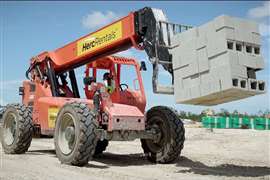Final Sellafield chimney begins its fall
16 April 2014

Work is now under way to decommission the final chimney that has dominated the skyline at the Sellafield nuclear facility in the UK. The Windscale Pile One chimney was the site for one of the UK’s most serious nuclear incidents when pile one caught fire in 1957. Fortunately, the high performance filter galleries that physicist John Cockcroft insisted be fitted to the top of the two chimneys on the site – which became known as the Cockcroft’s Follies because of the bulges they produced at the top of the already half built chimneys - prevented much of the radioactive contamination from escaping into the local environment. The contaminated filters were removed soon after the incident and the chimney was sealed to allow the radiation to decay.
The 530 tonne gallery is a large robust structure built from steel, concrete and brick and conventional demolition techniques are being used to remove it. Core drilling breaks up the concrete, with debris manually transferred to ground level by a small goods hoist inside the chimney. This means that only 1 tonne of debris can be moved at a time, meaning that 530 trips will be required.
Last year the chimney was opened up for the very first time in over 17 years and the filter dismantling access gantry was pulled apart to open the chimney to the elements in preparation for dismantling. The plan is that the filter gallery will be fully dismantled by October this year
The next stage is to remove the diffuser which is the box-like structure sitting below the filter gallery. Preparations will be made next year to erect a tower crane next to the chimney and the 1400 tonne concrete diffuser box will be cut up using diamond wire and lowered down in 7 tonne blocks. This new approach is estimated to improve the efficiency of the demolition by over 700% - which is both safer and more cost effective. This will ensure another skyline change at Sellafield by 2017/18 and the demolition of the chimney barrel a few years later.
Jeremy Hunt, Head of Decommissioning Projects said: “The decommissioning challenges posed by the Pile chimney are unique and no other structure in the world provides the same complexity in terms of both radiological and conventional decommissioning constraints. There’s no instruction manual for the job and we have to prove the decommissioning techniques chosen can be used 100% safely on the congested Sellafield site.”
The chimney is 110 m (361 ft) tall and there is over 5,000 tonnes of materials in total to be removed during full demolition of the chimney to ground level. It was built in the late 1940s as a ventilation shaft, rather than chimney, and discharged cooling air from one of the Windscale Pile Reactors. The Piles were conceived in the aftermath of WWII, as part of the drive to develop a nuclear deterrent. Their primary purpose was to provide nuclear materials and the heat generated was released to atmosphere rather than used to generate electricity.
Steve Slater, head of decommissioning said: “Almost 60 year after the Windscale Pile reactors ceased operation, the familiar landmarks of the West Cumbrian skyline are disappearing. The chimneys were a real technical achievement in terms of construction, which minimised the effect of the fire in 1957 and are testament to the nuclear pioneers who built them. Today, that early pioneering spirit has been captured again, as our engineers and scientists are leading the field in developing and applying innovative technology and techniques to decommission Sellafield. We’re using the considerable nuclear expertise built up at Sellafield to safely bring the final chimney down.”






